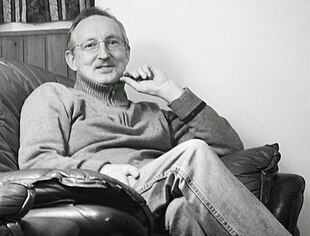Biography:David Bevan (mathematician)
David Bevan | |
|---|---|
 | |
| Born | 16 November 1961 Whitehaven, England |
| Nationality | British |
| Alma mater | The Queen's College, Oxford London School of Theology The Open University |
| Scientific career | |
| Fields | Mathematics Computer science |
| Institutions | General Electric Company Summer Institute of Linguistics Pitney Bowes The Open University University of Strathclyde |
| Doctoral advisor | Robert Brignall.[1] |
| Website | www |
David Bevan is an English mathematician, computer scientist and software developer. He is known for Bevan's theorem, which gives the asymptotic enumeration of grid classes of permutations[2][3] and for his work on enumerating the class of permutations avoiding the pattern 1324.[3][4] He is also known for devising weighted reference counting, an approach to computer memory management that is suitable for use in distributed systems.[5][6]
Work and research
Bevan is a lecturer in combinatorics in the department of Mathematics and Statistics at the University of Strathclyde.[7][8][9] He has degrees in mathematics and computer science from the University of Oxford and a degree in theology from the London School of Theology.[10] He received his PhD in mathematics from The Open University in 2015; his thesis, On the growth of permutation classes, was supervised by Robert Brignall.[1]
In 1987, as a research scientist at GEC's Hirst Research Centre in Wembley, he developed an approach to computer memory management, called weighted reference counting, that is suitable for use in distributed systems.[5][6] During the 1990s, while working for the Summer Institute of Linguistics in Papua New Guinea, he developed a computer program, called FindPhone, that was widely used by field linguists to analyse phonetic data in order to understand the phonology of minority languages.[11][12][13] While employed by Pitney Bowes, he was a major contributor to the development of the FreeType text rendering library.[14]
Bevan's mathematical research has concerned areas of enumerative combinatorics, particularly in relation to permutation classes.[3] He established that the growth rate of a monotone grid class of permutations is equal to the square of the spectral radius of a related bipartite graph.[2][3] He has also determined bounds on the growth rate of the class of permutations avoiding the pattern 1324.[3][4] In the Acknowledgements sections of his journal articles, he often includes the Latin phrase Soli Deo gloria.[15][16][17]
Selected publications
- Bevan, D. I. (1987). "Distributed garbage collection using reference counting". Springer. pp. 176–187.
- Bevan, David (1995). FindPhone: Phonological analysis for the field linguist. Summer Institute of Linguistics.
- Bevan, David (2015). "Growth rates of permutation grid classes, tours on graphs, and the spectral radius". Trans. Amer. Math. Soc. 367 (8): 5863–5889. doi:10.1090/s0002-9947-2015-06280-1. http://oro.open.ac.uk/38963/1/GrowthRatesRevision3.pdf.
- Bevan, David (2015). "Permutations avoiding 1324 and patterns in Łukasiewicz paths". J. London Math. Soc. 92 (1): 105–122. doi:10.1112/jlms/jdv020. http://oro.open.ac.uk/43872/1/1324LukaJLMS.pdf.
External links
References
- ↑ 1.0 1.1 David Bevan at the Mathematics Genealogy Project
- ↑ 2.0 2.1 Albert, Michael; Vatter, Vincent (2019). "An elementary proof of Bevan's theorem on the growth of grid classes of permutations". Proc. Edinb. Math. Soc. (2) 62 (4): 975–984. doi:10.1017/S0013091519000026.
- ↑ 3.0 3.1 3.2 3.3 3.4 Vatter, Vincent (2015). "Permutation classes". in Bóna, Miklós. The Handbook of Enumerative Combinatorics. CRC Press.
- ↑ 4.0 4.1 Egge, Eric S. (2015). "Defying God: the Stanley-Wilf Conjecture, Stanley-Wilf Limits, and a Two-Generation Explosion of Combinatorics". in Kennedy, Stephen F.. A Century of Advancing Mathematics. Mathematical Association of America.
- ↑ 5.0 5.1 Plainfossé, David; Shapiro, Marc (1995). "A survey of distributed garbage collection techniques". Springer. pp. 211–249.
- ↑ 6.0 6.1 Jones, Richard; Lins, Rafael (1996). Garbage Collection: Algorithms for Automatic Dynamic Memory Management. Wiley.
- ↑ Staff | University of Strathclyde
- ↑ Dr David Bevan | University of Strathclyde
- ↑ The Strathclyde Combinatorics Group
- ↑ Curriculum vitae from Dr David Bevan's Open University webpage
- ↑ Johnston, E. Clay (1995). "Computer software to assist linguistic field work". Cahiers des Sciences Humaines 31 (7): 103–129.
- ↑ Antworth, Evan L.; Valentine, J. Randolph (1998). "Software for doing field linguistics". in Lawler, John; Aristar Dry, Helen. Using Computers in Linguistics: A Practical Guide. Routledge. https://archive.org/details/usingcomputersin00john.
- ↑ Hunt, Geoffrey (2008). "A comparison of phonology tools". SIL Forum for Language Fieldwork 2008-009.
- ↑ FreeType Authors & Developers
- ↑ Bevan, David (2014). "Growth rates of geometric grid classes of permutations". Electron. J. Combin. 13 (1): Paper 4.51, 17 pages. Bibcode: 2013arXiv1306.4246B.
- ↑ Bevan, David (2015). "Permutations avoiding 1324 and patterns in Łukasiewicz paths". J. London Math. Soc. 92 (1): 105–122. doi:10.1112/jlms/jdv020. http://oro.open.ac.uk/43872/1/1324LukaJLMS.pdf.
- ↑ Bevan, David (2017). "Intervals of permutation class growth rates". Combinatorica.
 |

